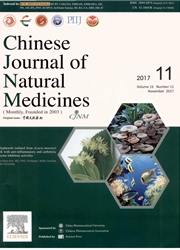

 中文摘要:
中文摘要:
分离、鉴定具有抗丙型肝炎(HCV)作用的熊胆蛋白大分子物质,并从代谢组学角度评价熊胆大分子物质对HCV感染树晌动物模型的治疗作用,鉴定代谢标记物,探讨相关作用机制。以易感HCV的树晌建立丙型肝炎动物病理模型,应用代谢组学方法,采用超高效液相串联高分辨质谱(UPLC—HDMS/MS)技术对动物模型进行分析评价,应用有监督的正交偏最小方差判别分析(OPLS.DA),表征丙型肝炎树晌模型潜在生物标记物,揭示熊胆粉中大分子物质抗HCV作用及相关作用机制。采用液质联用技术结合主成分分析的方法,正常树嗣和模型树晌的代谢产物在PCA图中得到了清晰的区分,造模后树晌内源性代谢网络发生了显著变化,确立了38个具有显著分类意义的HCV树驹模型潜在生物标记物,涉及磷脂、肉碱、脂肪酸、胆酸等代谢通路。熊胆大分子物质具有明显的抗HCV活性作用,为熊胆大分子物质成为HCV候选药物奠定基础。
 英文摘要:
英文摘要:
Metabolomics represents an emerging and powerful discipline that provides an accurate and dynamic picture of the phenotype of bio-systems through the study of potential metabolites that could be used as therapeutic targets and for the discovery of new drugs. Hepatitis C virus (HCV) is a leading cause of liver disease worldwide, and is a major burden on public health. It is hypothesized that an animal mode/ of HCV infection would produce unique patterns of endogenous metabolites. Herein, a method for the construction of efficient networks is presented with regard to the proteins of bear bile powder (PBBP) that protect against HCV as a case study. Ultra-performance liquid chromatography, coupled with electrospray ionization/quadrupole-time-of-flight high definition mass spectrometry (UPLC-HDMS), coupled with pattern recognition methods and computational systems analysis were integrated to obtain comprehensive metabolomic profiling and pathways of the large biological data sets. Among the regulated pathways, 38 biomarkers were identified and two unique metabolic pathways were indicated to be differentially affected in HCV animals. The results provided a systematic view of the development and progression of HCV, and also could be used to analyze the therapeutic effects of PBBP, a widely used anti-HCV medicine. The results also showed that PBBP could provide satisfactory effects on HCV infection through partially regulating the perturbed pathway. The most promising use in the near future would be to clarify the pathways for the drugs and obtain biomarkers for these pathways to help guide testable predictions, provide insights into drug action mechanisms, and enable an increase in research productivity toward metabolomic drug discovery.
 同期刊论文项目
同期刊论文项目
 同项目期刊论文
同项目期刊论文
 Ultra-performance LC-ESI/quadrupole-TOF MS for rapid analysis of chemical constituents of Shaoyao-Ga
Ultra-performance LC-ESI/quadrupole-TOF MS for rapid analysis of chemical constituents of Shaoyao-Ga Rapid identification and comparative analysis of chemical constituents and metabolites of Phellodend
Rapid identification and comparative analysis of chemical constituents and metabolites of Phellodend Chemical Discrimination of Cortex Phellodendri amurensis and Cortex Phellodendri chinensis by Multiv
Chemical Discrimination of Cortex Phellodendri amurensis and Cortex Phellodendri chinensis by Multiv Rapid discovery and global characterization of chemical constituents and rats metabolites of Phellod
Rapid discovery and global characterization of chemical constituents and rats metabolites of Phellod Identification and characterization of the chemical constituents of Simiao Wan by ultra high perform
Identification and characterization of the chemical constituents of Simiao Wan by ultra high perform Fingerprinting and simultaneous determination of alkaloids and limonins in Phellodendri amurensis co
Fingerprinting and simultaneous determination of alkaloids and limonins in Phellodendri amurensis co UPLC-MS coupled with a dynamic multiple data processing method for the comprehensive detection of th
UPLC-MS coupled with a dynamic multiple data processing method for the comprehensive detection of th Metabolomics and proteomics approaches to characterize and assess proteins of bear bile powder for h
Metabolomics and proteomics approaches to characterize and assess proteins of bear bile powder for h Comparative Study on the Protective Effects of Yinchenhao Decoction (sic) against Liver Injury Induc
Comparative Study on the Protective Effects of Yinchenhao Decoction (sic) against Liver Injury Induc Analysis of the constituents in the rat plasma after oral administration of Yin Chen Hao Tang by UPL
Analysis of the constituents in the rat plasma after oral administration of Yin Chen Hao Tang by UPL Development of a rapid and validated method for investigating the metabolism of scoparone in rat usi
Development of a rapid and validated method for investigating the metabolism of scoparone in rat usi Hydrolysis of Flavanone Glycosides and Degradation of the Corresponding Aglycones from Dried Immatur
Hydrolysis of Flavanone Glycosides and Degradation of the Corresponding Aglycones from Dried Immatur Quality evaluation of Yin Chen Hao Tang extract based on fingerprint chromatogram and simultaneous d
Quality evaluation of Yin Chen Hao Tang extract based on fingerprint chromatogram and simultaneous d Pharmacokinetics of Cimifugin in Rat Plasma after Oral Administration of the Extract of Saposhnikovi
Pharmacokinetics of Cimifugin in Rat Plasma after Oral Administration of the Extract of Saposhnikovi Simultaneous determination of 6,7-dimethylesculetin and geniposide in rat plasma and its application
Simultaneous determination of 6,7-dimethylesculetin and geniposide in rat plasma and its application Simultaneous determination by UPLC-ESI-MS of scoparone, capillarisin, rhein, and emodin in rat urine
Simultaneous determination by UPLC-ESI-MS of scoparone, capillarisin, rhein, and emodin in rat urine Development and validation of a ultra performance LC-ESI/MS method for analysis of metabolic phenoty
Development and validation of a ultra performance LC-ESI/MS method for analysis of metabolic phenoty HPLC method for preliminary analysis of constituents in rat blood after oral administration of the e
HPLC method for preliminary analysis of constituents in rat blood after oral administration of the e 期刊信息
期刊信息
